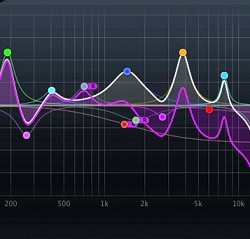Whenever an engineer has trouble dialing in the EQ on a track, chances are its because of one or more of the 6 trouble frequency areas.
These are areas where too much or too little can cause your track to either stick out like a sore thumb, or disappear into the mix completely. Let’s take a look.
200Hz (Mud) – Too much can cause the track or the mix to sound muddy or boomy, while not enough of it can make it sound thin. It’s a fine line, but many times mixers err on the side of too much and end up with a track that’s too thick that clutters up the mix.
300 to 500Hz (Boxy) – Too much of this frequency area results in the dreaded “boxiness” sound, or if you’re listening to a floor tom or kick, the “beach ball” effect. It’s also a spot that some less expensive microphones (especially dynamics) tend to emphasize, which is why many mixers almost automatically cut a a few dB of this area out of the kick drum during the mix.
800Hz (Walmart) – Too much in this area results in what’s sometimes known as the “Walmart” sound, meaning that it sounds like a cheap stereo purchased in a department store. Try it for yourself – get a cheap pair of computer speakers and you’ll find that 800Hz is what you’ll mostly hear. Obviously, too much of this frequency range is not a good thing.
1k to 1.5kHz (Nasal) – This is the nasal range of the frequency spectrum and, as the name suggests, too much results in a vocalist that sounds like she’s singing through her nose. Once again this is primarily a microphone problem in that it’s poorly matched to the vocalist, but notching a bit out during the mix can fix it.
4kHz to 6kHz (Presence) – This frequency range is frequently underutilized during the mix, resulting in a track that lacks definition. Without it, things tend to sound dull, but too much can make the track sound thin or, in the case of a vocal, sibilant.
10kHz+ (Air) – Another widely overlooked frequency band, this provides clarity and adds a certain “realness” to the track. Many vintage mics have a lot of the air frequencies, which is why we prize them for their sound. The Maag Audio EQ4P has a special “Air Band” designed to provide those frequencies with a minimum of phase shift, but you can dial it in other equalizers as well.
Sometimes just tweaking a few of these 6 frequency ranges can take a mix from dull to exciting, or muddy to clear, so keep them in mind during your next mix.
Read and comment on the original article here.
Bobby Owsinski is an author, producer, music industry veteran and technical consultant who has written numerous books covering all aspects of audio recording. For more information be sure to check out his website and blog. Go here to check out The Mixing Engineer’s Handbook.
















